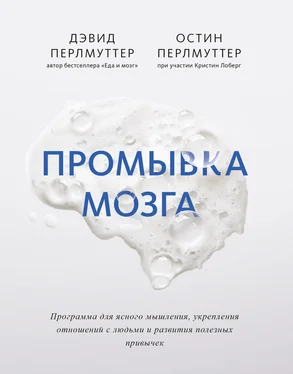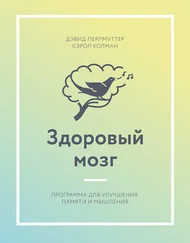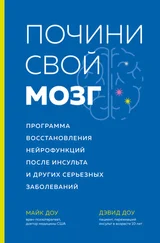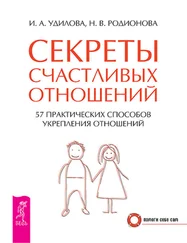J. J. Iliff et al. “A Paravascular Pathway Facilitates CSF Flow Through the Brain Parenchyma and the Clearance of Interstitial Solutes, Including Amyloid β,” Sci. Transl. Med. 4, № 147 (August 2012): 147ra111.
L. Xie et al. “Sleep Drives Metabolite Clearance from the Adult Brain,” Science 342, № 6156 (October 2013): 373–377.
E. Shokri-Kojori et al. “β-Amyloid Accumulation in the Human Brain After One Night of Sleep Deprivation,” Proc. Natl. Acad. Sci. USA 115, № 17 (April 2018): 4483–4488.
P. Li et al. “Beta-Amyloid Deposition in Patients with Major Depressive Disorder with Differing Levels of Treatment Resistance: A Pilot Study,” EJNMMI Res. 7, № 1 (December 2017): 24; см. также S. Perin et al. “Amyloid Burden and Incident Depressive Symptoms in Preclinical Alzheimer’s Disease,” J. Affect. Disord. 229 (March 2018): 269–274.
E. Flores-Martinez and F. Peña-Ortega. “Amyloid β Peptide-Induced Changes in Prefrontal Cortex Activity and Its Response to Hippocampal Input,” Int. J. Pept. 12 (January 2017): 1–9.
B. T. Kress et al. “Impairment of Paravascular Clearance Pathways in the Aging Brain,” Ann. Neurol. 76, № 6 (December 2014): 845–861.
S. Yoo et al. “The Human Emotional Brain Without Sleep – A Prefrontal Amygdala Disconnect,” Curr. Biol. 17, № 20 (2007): 877–878.
Источник: Seung-Schik Yoo et al., Current Biology 17 (20): R877–8. October 2007.
E. van der Helm and M. P. Walker. “Overnight Therapy? The Role of Sleep in Emotional Brain Processing,” Psychol. Bull. 135, № 5 (September 2009): 731–748.
A. N. Goldstein and M. P. Walker. “The Role of Sleep in Emotional Brain Function,” Annu. Rev. Clin. Psychol. 10 (2014): 679–708.
Y. Motomura et al. “Two Days’ Sleep Debt Causes Mood Decline During Resting State via Diminished Amygdala-Prefrontal Connectivity,” Sleep 40, № 10 (October 2017).
E. Ben Simon and M. P. Walker. “Sleep Loss Causes Social Withdrawal and Loneliness,” Nat. Commun. 9, № 3146 (August 2018).
K. J. Brower and B. E. Perron. “Sleep Disturbance as a Universal Risk Factor for Relapse in Addictions to Psychoactive Substances,” Med. Hypotheses 74, № 5 (May 2010): 928–933.
Grand View Research. “Insomnia Therapeutics Market Analysis by Treatment Type [Devices, Drugs (Benzodiazepines, Nonbenzodiazepines, Antidepressants, Orexin Antagonists, Melatonin Antagonists)], by Sales Channel, and Segment Forecasts, 2018–2025,” October 2017. https://www.grandviewresearch.com/industry-analysis/insomnia-therapeutics-market.
Yinong Chong, Cheryl D. Fryar, and Quiping Gu. “Prescription Sleep Aid Use Among Adults: United States, 2005–2010,” Centers for Disease Control and Prevention, NCHS Data Brief 127, August 2013. https://www.cdc.gov/nchs/products/databriefs/db127.htm.
T. B. Huedo-Medina et al. “Effectiveness of Non-Benzodiazepine Hypnotics in Treatment of Adult Insomnia: Meta-Analysis of Data Submitted to the Food and Drug Administration,” BMJ 345 (December 2012): e8343.
D. F. Kripke, R. D. Langer, and L. E. Kline. “Hypnotics’ Association with Mortality or Cancer: A Matched Cohort Study,” BMJ Open 2 (2012): e000850.
D. F. Kripke. “Hypnotic Drug Risks of Mortality, Infection, Depression, and Cancer: But Lack of Benefit,” version 3, F1000Res. 5 (2016): 918.
Kripke. “Hypnotic Drug Risks.”
A. M. Chang et al. “Evening Use of Light-Emitting eReaders Negatively Affects Sleep, Circadian Timing, and Next-Morning Alertness,” Proc. Natl. Acad. Sci. USA 112, no. 4 (January 2015): 1232–1237.
J. M. Zeitzer et al. “Sensitivity of the Human Circadian Pacemaker to Nocturnal Light: Melatonin Phase Resetting and Suppression,” J. Physiol. 526, part 3 (August 2000): 695–702.
A. Garcia-Saenz et al. “Evaluating the Association Between Artificial Light-at-Night Exposure and Breast and Prostate Cancer Risk in Spain (MCC-Spain Study),” Environ. Health Perspect. 126, № 4 (April 2018): 047011.
P. James et al. “Outdoor Light at Night and Breast Cancer Incidence in the Nurses’ Health Study II,” Environ. Health Perspect. 125, № 8 (August 2017): 087010.
T. A. Bedrosian and R. J. Nelson. “Timing of Light Exposure Affects Mood and Brain Circuits,” Transl. Psychiatry 7, № 1 (January 2017): e1017.
Common Sense Media. “The Common Sense Census: Media Use by Kids Age Zero to Eight 2017”. https://www.commonsensemedia.org/research/the-common-sense-census-media-use-by-kids-age-zero-to-eight-2017.
The National Sleep Foundation’s Sleep in America poll. https://www.sleepfoundation.org/sites/default/files/inline-files/Highlights_facts_06.pdf.
A. Shechter et al. “Blocking Nocturnal Blue Light for Insomnia: A Randomized Controlled Trial,” J. Psychiatr. Res. 96 (January 2018): 196–202.
F. H. Rångtell et al. “Two Hours of Evening Reading on a Self-Luminous Tablet vs. Reading a Physical Book Does Not Alter Sleep After Daytime Bright Light Exposure,” Sleep Med. 23 (July 2016): 111–118.
D. A. Raichlen and A. D. Gordon. “Relationship Between Exercise Capacity and Brain Size in Mammals,” PLoS One 6, № 6 (June 2011): e20601; см. также D. A. Raichlen and J. D. Polk. “Linking Brains and Brawn: Exercise and the Evolution of Human Neurobiology,” Proc. Biol. Sci. 280, № 1750 (January 2013): 201222550.
M. Moriya, C. Aoki, and K. Sakatani. “Effects of Physical Exercise on Working Memory and Prefrontal Cortex Function in Post-Stroke Patients,” Adv. Exp. Med. Biol. 923 (2016): 203–208; см. также T. Tsujii, K. Komatsu, and K. Sakatani. “Acute Effects of Physical Exercise on Prefrontal Cortex Activity in Older Adults: A Functional Near-Infrared Spectroscopy Study,” Adv. Exp. Med. Biol. 765 (2013): 293–298.
S. Dimitrov, E. Hulteng, and S. Hong. “Inflammation and Exercise: Inhibition of Monocytic Intracellular TNF Production by Acute Exercise via β2-Adrenergic Activation,” Brain Behav. Immun. 61 (March 2016): 60–68.
D. Aune et al. “Physical Activity and the Risk of Type 2 Diabetes: A Systematic Review and Dose-Response Meta-Analysis,” Eur. J. Epidemiol. 30, № 7 (July 2015): 529–542.
E. E. Hill et al. “Exercise and Circulating Cortisol Levels: The Intensity Threshold Effect,” J. Endocrinol. Invest. 31, № 7 (July 2008): 587–591.
D. E. Lieberman. “Is Exercise Really Medicine? An Evolutionary Perspective,” Curr. Sports Med. Rep. 14, № 4 (July-August 2015): 313–19; см. также D. E. Lieberman. The Story of the Human Body: Evolution, Health, and Disease (New York: Pantheon, 2013).
Читать дальше
Конец ознакомительного отрывка
Купить книгу




![Дэвид Доу - Почини свой мозг. Программа восстановления нейрофункций после инсульта и других серьезных заболеваний [litres]](/books/431118/devid-dou-pochini-svoj-mozg-programma-vosstanovlen-thumb.webp)







